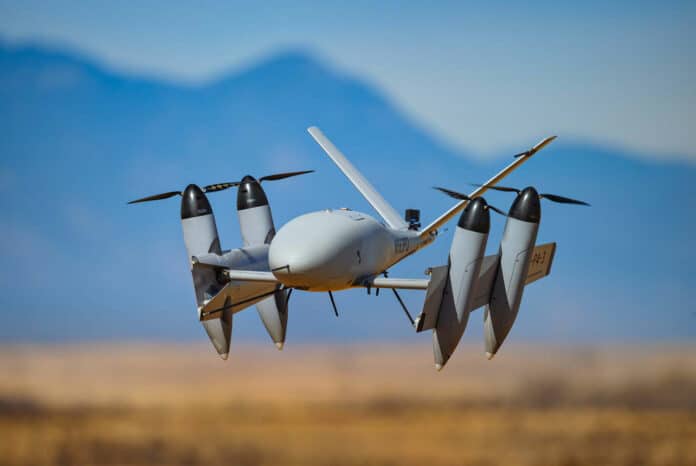PteroDynamics has been making waves in the electric vertical takeoff and landing (eVTOL) aircraft market with its innovative Transwing platform. And now, the company has announced the successful demonstration of the advanced capabilities of its automated Transwing vertical takeoff and landing (VTOL) unmanned aerial vehicle system (UAS) at sea during the U.S. 4th Fleet Hybrid Fleet Campaign Event (HFCE).
During the six-day event, PteroDynamics demonstrated the unique capabilities of the Transwing aircraft to integrate UAS into the fleet for ship-to-ship and ship-to-shore logistics and critical maritime resupply missions. Transwing aircraft made nine autonomous launch and recovery flights from the deck of the USNS Burlington in Key West, Florida.
The design of the Transwing aircraft is quite unique in the world of aviation. It offers significant benefits with very few drawbacks. It’s a cruise-capable, transitioning eVTOL airframe that uses a unique dihedral folding wing system to move between hover and cruise modes.
The wings of the aircraft fold during flight, allowing the aircraft to transition between rotor wing and fixed wing configurations. The four propellers on the wings remain fixed in place, but they rotate from fully horizontal to face vertically upward when the wings are folded in.
Interestingly, it does not need tilting propulsion systems or lift/cruise props that add weight and drag and are only useful for vertical takeoff and landing. Additionally, the back tips of the propulsion nacelles can double as landing points, further reducing the need for additional equipment.
This makes it one of the lightest, most efficient, and lowest-drag transitioning VTOL airframes we have seen. The aircraft has a smaller ground footprint while being able to fly farther, faster, longer, and carry heavier payloads than other VTOL aircraft of a similar size and weight. It still weighs more than a fixed-wing plane, but the difference is minimal. This is critical for everything from drone delivery to air taxis with extensive government, defense, industrial, and commercial applications as well.
The X-P4 is the latest prototype from Pterodynamics that has a wingspan of 13 feet (4 meters) and can carry up to 15 lb (6.8 kg) of payload. The drone has a maximum takeoff weight (MTOW) of 84 lb (38 kg) and can fly for an hour at a cruising speed of 60 knots (111 km/h) or reach a top speed of 100 knots (185 km/h) in short bursts.
The company has ambitious plans to scale up its technology and create a larger and more powerful version of the drone. The next model, the X-P5, will have a wingspan of 22 feet (6.7 meters) and will be able to carry 50 pounds (23 kg) of payload. The X-P5 will use a hybrid power system and will have a range of 500 nautical miles (925 km).
The ultimate goal of the company is the X-P6, which will have a wingspan of 30 feet (9.1 meters) and will be able to carry 220 pounds (100 kg) of payload. The X-P6 will use a turbogenerator powertrain that will enable it to fly for 850 nautical miles (1,574 km).
“Participating in The Hybrid Fleet Campaign Event brought us closer to our goal of providing the U.S. Navy with a flexible and scalable shore-to-ship, ship-to-ship, and ship-to-shore automated cargo delivery capability,” said Tim Whitehand, PteroDynamics vice president of engineering. “Flight testing on board the USNS Burlington gave us a unique and valuable opportunity to collect performance data on the Transwing system in an operational environment. The information gathered during the event will accelerate development and seed further innovation. We are grateful for the opportunity to participate in this important exercise and the support of the Naval Air Warfare Center Aircraft Division (NAWCAD) and Naval Air Systems Command (NAVAIR).”
